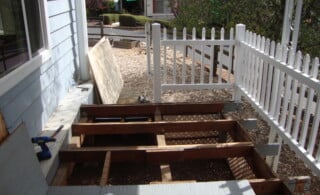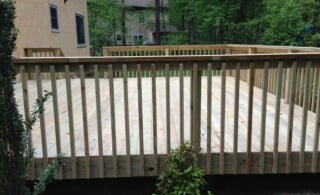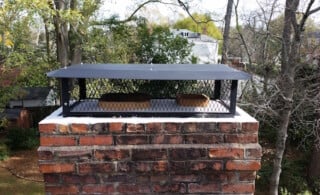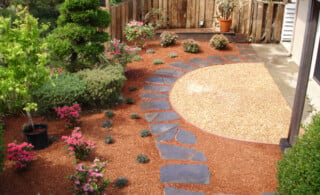
Have you ever been a visitor in a home that just gives you the creeps? Maybe it smells a little musky. Perhaps old floorboards creak eerily. Lights may flicker, and appliances may turn off and on all by themselves. You may even see shadowy figures or feel as if you’re being watched. Chances are that you have had at least one of these experiences in your lifetime — and, chances are that you high-tailed it out of there just as quickly as you could.
But what do you do if that house is your own? What if your home is the one that everyone thinks is haunted? The good news is that it’s (probably) not. Regardless of whether you believe in ghosts, most paranormal activity can be explained with science, and most of it can be remedied with basic maintenance and minor repairs. Read on for help identifying and addressing the issues that are making your family members or guests uncomfortable.
Changes in Temperature
Does your house have areas where the temperature is inconsistent, no matter how many times you check the thermostat? There are several possible explanations for this phenomenon, and none of them have anything to do with the paranormal.
Air Leaks
The odds are that your home isn’t haunted. It’s drafty. Either your doors and windows are letting in air where they shouldn’t, or subpar insulation isn’t protecting your house from outdoor temperatures. To identify the areas of your home that need attention, you can hire a professional energy auditor near you with special, infrared instruments. For a DIY solution, hold a lit stick of incense (or sage, if you’re really concerned about a haunting!) next to your windows, doors, and walls in the areas of your home where cold spots persist. Sideways smoke indicates that air is leaking into your home from outdoors.
To fix the problem, you can hire a weather-stripping contractor or apply some DIY fixes. Start by adding caulk or weather-stripping around windows and door frames, or installing an interior window sealer. Thermal drapes and curtains are another easy, affordable option. If the problem persists, you may need to hire a nearby insulation installer to add or replace insulation in your ceilings and walls. Eliminating the drafty areas in your home will not only put you and your guests at ease, but it can also lessen your energy usage to lower your heating and cooling bills.
Low Humidity
While a lack of humidity won’t cause temperatures to be colder in certain areas of your home, it can feel that way. So, after you’ve eliminated air leaks but before you call the ghost hunters, consider testing the air in the living spaces in question. Many smart thermostats and indoor, digital thermometers will tell you, or you can use the ice cube method. Simply place four ice cubes in a glass, and set it in the room in question. If after three or four minutes the glass is sweating, the room is humid. If there are no drops on the outside of the glass, consider placing a home humidifier in the space to increase it to between 35 and 50 percent.
Creaky Floors and Doors
Creaky floors, even when no one is walking on them, are hard to ignore. So are doors, cabinets, and drawers that open on their own. But just because you aren’t controlling them doesn’t mean ghosts are. Here’s what might be causing it — and how to fix it.
Low Humidity (Again)
Once again, dry air may be to blame. Dry air sucks the moisture from the wood in your floorboards and furnishings, causing it to shrink. This shrinkage (and any accompanying expansion when the air gets more humid) can lead to warping which, in turn, can cause the creepy conditions. To increase the humidity in your home, pick a humidifier for the size of your space. You can also leave the bathroom door open while you shower to fill your home with more humid air.
Hardware
Another potential cause of cabinets and drawers that open without human help could be as simple as cheap, nylon hardware. There are DIY door and drawer locks you can install yourself. Ball-bearing assemblies and quality hinges can keep your cabinet doors and drawers exactly where you left them, so call a cabinet repair contractor in your area who can replace existing hardware.
Power Surges
Flickering lights and appliances that turn on and off by themselves are not only scary; they’re dangerous. Aside from problems with a particular switch or appliance, these instances can indicate more serious problems with the electrical system in your home.
Faulty Appliances
If a specific appliance or electronic is causing you concern, check into it online. SaferProducts.gov allows you to search for reports and recalls by category or appliance. You can also report unusual activity there. If more than one appliance is acting paranormal, you may have a bigger problem with the electrical wiring in your home.
Faulty Wiring
Storms can cause power surges that affect your whole home, but if lights are turning off and on intermittently, it could be a loose wire or faulty circuit. These problems are a fire hazard, so you should get them checked out immediately. Because electrical work is dangerous, you should always call a local licensed electrician to inspect the situation.
Smells and Sounds
Musty, old smells and curious sounds can make you, your family, and your guests uncomfortable in more ways than one. Unfortunately, they can also indicate other problems in your home, but the good news is that with the help of a few professionals, the issues are pretty simple to fix.
Unwanted Guests
As small as they are, rodents, insects, snakes, and bats make loud noises — especially when they move into your basement, attic, crawl space, or walls. They can also ruin appliances, chew through wiring, shred insulation, and leave droppings and food remnants behind, attracting even more pests. If you suspect you have a pest problem, contact a pest control professional near you. Not only will they help trap and treat for pests, but they can also identify where they are gaining access so you can keep them out for good.
Utilities
If you hear lots of pings, knocks, and bangs, your HVAC system may be to blame. When heat and metal interact, these types of noises abound. Plumbing lines can also cause a racket, due to the changing pressure in the pipes or fast-closing washer valves. But before you pack up and move out, hire a local HVAC technician or call a plumber in your area. They can dampen the noise by adding sound-absorbing material, regulating pressure, or installing a water hammer arrestor.
Infrasound
Infrasound is basically a fancy term for sounds that are below 20 Hertz. Infrasound is too low for humans to hear, but we can still feel its vibrations. This can cause a panicky sensation that some people misinterpret as a haunting. Common sources of infrasound include storms, wind, and appliances like your refrigerator. The best way to deal with infrasound is to simply know that it exists.
Ghost Stories
Even if you can explain away all of the other signs of paranormal activity, what if you or someone you know has actually seen a ghost in your home? As it turns out, there’s an explanation (or three) for this phenomenon too.
Mold
Put simply, mold can cause irrational fear and dementia. So, if you think you’ve seen a ghost, check behind the walls and under the house for the toxic substance. If you see signs of mold growth, don’t attempt to remove it yourself. Small areas of mold, common in bathrooms or other moist areas, can be taken care of with bleach-based cleaners. Larger areas pose a significant health risk, so you should always call a mold inspector near you to inspect, test for, and eliminate toxic mold.
Carbon Monoxide
Carbon monoxide poisoning can also cause you to hallucinate, hear things, and feel weak. Other symptoms include headache, fatigue, shortness of breath, nausea, and dizziness. A faulty furnace, poor ventilation, or leaving your car running in the attached garage are just a few ways that invisible, odorless carbon monoxide can reach dangerous levels in your home. If you suspect you have been exposed, leave your home immediately, and call the fire department. And, of course, every home should be equipped with carbon monoxide detectors, and they should be checked regularly.
Ions
While ghost hunters carry ion counters to help verify paranormal activity, ions are actually present everywhere, all the time. They are what causes our hair to stand on end and that shock we feel from static. Everything from weather to solar radiation to radon gas can cause ions. They can be negative or positive, and each type has a different effect. Positive ions can cause headaches, for example. Negative ions, on the other hand, can be calming. If you need to add relaxing, negative ions to your home, you can do so with a Himalayan salt lamp or a negative ion generator.
Next time you hear a creepy sound while you’re curled up on the couch or feel a burst of cool air as you are walking down the hall, don’t panic. There is (almost) always a scientific reason behind what’s happening, no matter how surprising or abnormal. Even better, there’s almost always a way to fix it. Whether you do it yourself or call a pro, just follow this guide, and you’ll have a haunt-free habitat before you can say “BOO!”
 Simple Home Repair and Maintenance Tips for Everyone
Simple Home Repair and Maintenance Tips for Everyone  Wood Deck Maintenance
Wood Deck Maintenance  Preventive Maintenance: Chimneys
Preventive Maintenance: Chimneys  Dry Well Cleaning & Maintenance Tips
Dry Well Cleaning & Maintenance Tips  Spring Maintenance Checklist – More Than Cleaning
Spring Maintenance Checklist – More Than Cleaning 

Are You Familiar With This Topic? Share Your Experience.